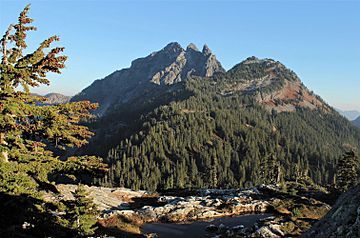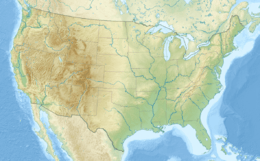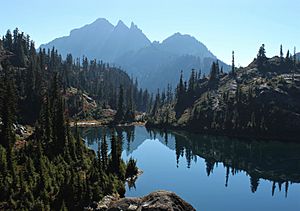Three Queens facts for kids
Quick facts for kids Three Queens |
|
|---|---|

Three Queens from northwest
|
|
| Highest point | |
| Elevation | 6,687 ft (2,038 m) |
| Prominence | 1,767 ft (539 m) |
| Isolation | 2.76 mi (4.44 km) |
| Parent peak | Chikamin Peak (7,000+ ft) |
| Geography | |
| Location | Kittitas County, Washington, U.S. |
| Parent range | Cascade Range |
| Topo map | USGS Chikamin Peak |
| Climbing | |
| First ascent | 1925 |
| Easiest route | class 3+ scrambling |
Three Queens is a tall mountain with three peaks, standing at about 6,687 feet (2,038 meters) high. It is located in the Cascade Range in Kittitas County, Washington state. This mountain is part of the beautiful Alpine Lakes Wilderness and is managed by the Wenatchee National Forest.
The highest of its three peaks is the East Peak. The other two are the Middle Peak (about 6,600 feet or 2,012 meters) and the West Peak (about 6,400 feet or 1,951 meters). Three Queens is located about 6.5 miles (10.5 kilometers) east-northeast of Snoqualmie Pass. It sits on Chikamin Ridge, not far from its taller neighbor, Chikamin Peak.
The Pacific Crest Trail, a famous long-distance hiking path, goes along the west side of Three Queens. Water from the mountain flows into streams that eventually join the Yakima River. The first time someone likely climbed Three Queens was in 1925. A group of eight climbers from The Mountaineers club, led by Glen Bremerman and C. A. Fisher, probably made this first ascent. The mountain's name, Three Queens, was officially chosen in 1940 by the United States Board on Geographic Names.
Weather at Three Queens
Three Queens is in a "marine west coast" climate zone. This means it gets a lot of weather from the Pacific Ocean. Most weather systems travel from the ocean towards the Cascade Mountains.
When these weather systems hit the tall Cascade Mountains, they are forced to rise. As they go higher, they drop their moisture as rain or snow. This is why the western side of the Cascades gets a lot of precipitation, especially snow in winter.
During winter, the weather is often cloudy. But in the summer, high-pressure systems over the Pacific Ocean usually bring clear skies. This means there's often little or no cloud cover during the warmer months.
How the Mountains Formed
The Alpine Lakes Wilderness has some of the most rugged land in the Cascade Range. You can see jagged peaks, deep valleys carved by glaciers, and tall granite walls. There are also more than 700 mountain lakes scattered around.
Long, long ago, major geological events created the varied landscape and big changes in elevation across the Cascade Range. These changes in height also led to different climates, which then created different types of plant life in the area. The land here ranges from about 1,000 feet (300 meters) high in the lower areas to over 9,000 feet (2,700 meters) on Mount Stuart.
The Cascade Mountains started forming millions of years ago, during a time called the late Eocene Epoch. This happened because the North American Plate (a huge piece of Earth's crust) was slowly moving over the Pacific Plate. This movement caused many volcanic eruptions. Also, smaller pieces of Earth's crust, called terranes, helped create the North Cascades about 50 million years ago.
Later, during the Pleistocene period (which began over two million years ago), glaciers repeatedly moved across the land. These huge ice sheets scraped and shaped the landscape, leaving behind piles of rock. The last time glaciers melted away from the Alpine Lakes area was about 14,000 years ago. By 10,000 years ago, they had moved north of the Canada–US border.
The river valleys in this area have a "U" shape. This shape was created by those recent glaciers. The combination of land being pushed up (called uplift) and cracks forming in the Earth's crust (called faulting), along with the action of glaciers, has created the tall peaks and deep valleys you see in the Alpine Lakes Wilderness today.




